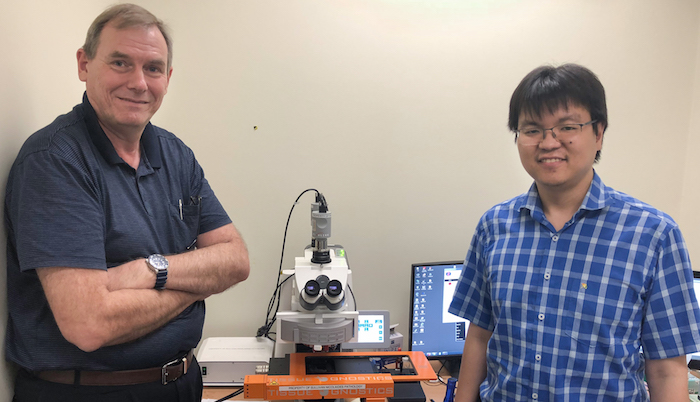
A University of Queensland research group is addressing the pressing issue of Australia’s pathologist shortage in the face of an ageing population.
Almost 70 per cent of Australian GPs base their diagnoses from pathology testing. The pace that Australia can train pathologists is much slower than the nation’s growing elderly population who are high users of health services.
Researchers in UQ’s Data Science Research Group, within the School of Information Technology and Electrical Engineering, are developing technologies to make pathology workflows much faster, more efficient and more cost-effective. The three-pronged approach consists of:
- image analytics based on artificial intelligence to help pathologists in performing their analysis — increasing capacity without extending work time.
- developing fast, precision-scanning technology to transform a glass slide used in pathology into a digital slide for quicker analysis, distribution and storage. Digital slides will help to train the next generation of Australian pathologists.
- data management and delivery technologies to allow Australia to store the slides indefinitely, creating a potential data bank which can be used for further research in precision and personal medicine.
The Digital Pathology project team — led by UQ’s Prof. Brian Lovell and Dr Arnold Wiliem, and Peter Hobson and Anthony Jennings from Sullivan Nicolaides Pathology (SNP) — uses computer vision, machine learning and pattern recognition methods to create scanning and image-based Computer Aided Diagnostic (CAD) systems.
The researchers are using UQ’s newest high-performance computer, Wiener, built for imaging-intensive science, to conduct the work.
Wiener, which features the most powerful Graphics Processing Units (GPUs) ever made, enables the researchers to train multiple machine learning models really fast using extremely large data sets. (For instance, a scanned image of a kidney is about 80,000 by 80,000 pixels. For comparison, photos from the latest iPhones are about 4,000 by 3,000 pixels.) To perform automatic analysis of the image, an artificial intelligence model needs to be trained using a large number of images.
“We have found Wiener allows us to perform the training five to eight times faster than our smaller, legacy GPUs. This enables us to further explore the solution space by testing several ideas at the same time,” said Dr Wiliem.
“Performing research is mainly bogged down by the waiting time of the training to finish which would take a couple of days. This means testing new ideas is quite slow. Wiener helps us in decreasing the training time significantly.”
The Digital Pathology project began in 2010 when SNP engaged Prof. Lovell and then Dr Wiliem on a funded project. The project received its first ARC Linkage Grant in 2013. In 2016, Dr Wiliem received an Advanced Queensland fellowship to continue his work. In 2017, the project received its second ARC Linkage grant until 2020.
As well as assisting pathologists working with GPs, the project has various applications in immunology, histopathology and microbiology.
One fully automated scanning system for immunology tests has already been deployed and routinely used within a pathology laboratory.
The research group are continuously creating a number of computer image data sets from different pathology areas. They publish the data sets openly and de-identify patient data. This effort is hoped to spur more interest from the community to advance this field.
“The overall aim of the project is to bring the digital pathology era into Australian laboratories. Technology adoption by these laboratories is a key issue that needs to be addressed in the near-term,” said Dr Wiliem.
A start-up company, Viscient, has been created as a stepping stone towards this goal by rolling out and providing support for technologies developed from the project.
“Currently, data has become the king and math is the queen. Fortunately, this project has a very unique position as it is not only developing key technologies to perform analytics, it is also working on technologies that make the data-generation process more streamlined within a laboratory workflow. As a result, we are now sitting on a goldmine of data, which is still continuously being generated every day.
“In the longer term, by utilising this data, we will be working closely with our stakeholders and pathology partners to explore and develop tools in general pathology areas,” said Dr Wiliem.
For more information about Wiener, please visit RCC’s website or contact: rcc-support@uq.edu.au.



